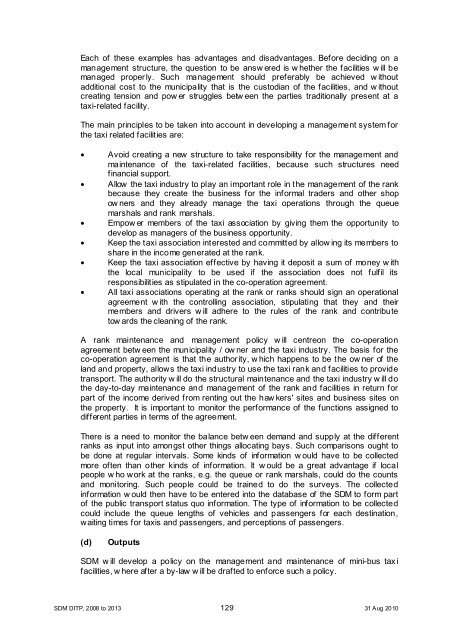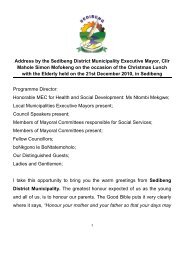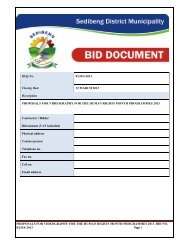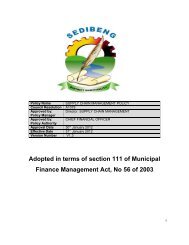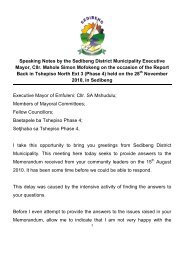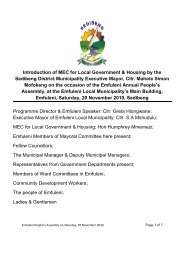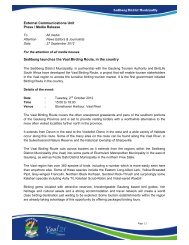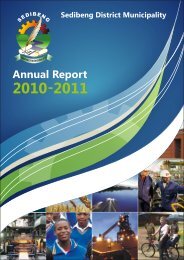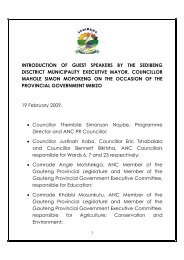Chapter 11 - Sedibeng District Municipality
Chapter 11 - Sedibeng District Municipality
Chapter 11 - Sedibeng District Municipality
You also want an ePaper? Increase the reach of your titles
YUMPU automatically turns print PDFs into web optimized ePapers that Google loves.
Each of these examples has advantages and disadvantages. Before deciding on a<br />
management structure, the question to be answ ered is w hether the facilities w ill be<br />
managed properly. Such management should preferably be achieved w ithout<br />
additional cost to the municipality that is the custodian of the facilities, and w ithout<br />
creating tension and pow er struggles betw een the parties traditionally present at a<br />
taxi-related facility.<br />
The main principles to be taken into account in developing a management system for<br />
the taxi related facilities are:<br />
• Avoid creating a new structure to take responsibility for the management and<br />
maintenance of the taxi-related facilities, because such structures need<br />
financial support.<br />
• Allow the taxi industry to play an important role in the management of the rank<br />
because they create the business for the informal traders and other shop<br />
ow ners and they already manage the taxi operations through the queue<br />
marshals and rank marshals.<br />
• Empow er members of the taxi association by giving them the opportunity to<br />
develop as managers of the business opportunity.<br />
• Keep the taxi association interested and committed by allow ing its members to<br />
share in the income generated at the rank.<br />
• Keep the taxi association effective by having it deposit a sum of money w ith<br />
the local municipality to be used if the association does not fulfil its<br />
responsibilities as stipulated in the co-operation agreement.<br />
• All taxi associations operating at the rank or ranks should sign an operational<br />
agreement w ith the controlling association, stipulating that they and their<br />
members and drivers w ill adhere to the rules of the rank and contribute<br />
tow ards the cleaning of the rank.<br />
A rank maintenance and management policy w ill centreon the co-operation<br />
agreement betw een the municipality / ow ner and the taxi industry. The basis for the<br />
co-operation agreement is that the authority, w hich happens to be the ow ner of the<br />
land and property, allows the taxi industry to use the taxi rank and facilities to provide<br />
transport. The authority w ill do the structural maintenance and the taxi industry w ill do<br />
the day-to-day maintenance and management of the rank and facilities in return for<br />
part of the income derived from renting out the haw kers' sites and business sites on<br />
the property. It is important to monitor the performance of the functions assigned to<br />
different parties in terms of the agreement.<br />
There is a need to monitor the balance betw een demand and supply at the different<br />
ranks as input into amongst other things allocating bays. Such comparisons ought to<br />
be done at regular intervals. Some kinds of information w ould have to be collected<br />
more often than other kinds of information. It w ould be a great advantage if local<br />
people w ho work at the ranks, e.g. the queue or rank marshals, could do the counts<br />
and monitoring. Such people could be trained to do the surveys. The collected<br />
information w ould then have to be entered into the database of the SDM to form part<br />
of the public transport status quo information. The type of information to be collected<br />
could include the queue lengths of vehicles and passengers for each destination,<br />
waiting times for taxis and passengers, and perceptions of passengers.<br />
(d)<br />
Outputs<br />
SDM w ill develop a policy on the management and maintenance of mini-bus tax i<br />
facilities, w here after a by-law w ill be drafted to enforce such a policy.<br />
SDM DITP, 2008 to 2013 129 31 Aug 2010


